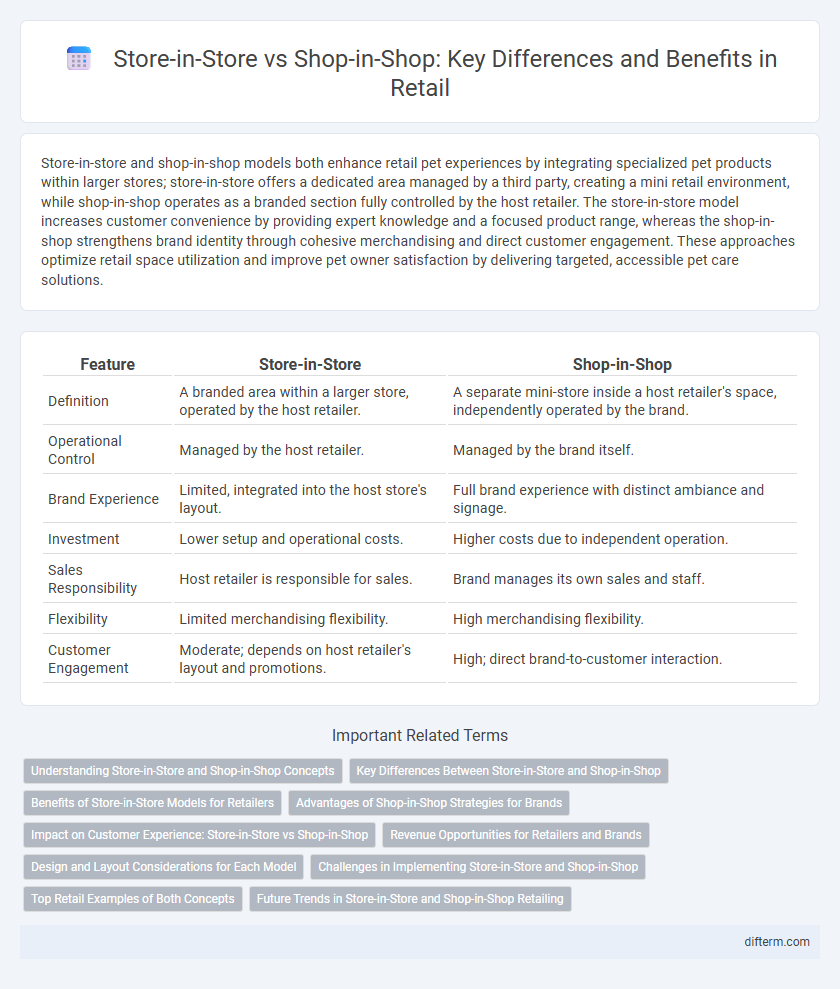Store-in-store and shop-in-shop models both enhance retail pet experiences by integrating specialized pet products within larger stores; store-in-store offers a dedicated area managed by a third party, creating a mini retail environment, while shop-in-shop operates as a branded section fully controlled by the host retailer. The store-in-store model increases customer convenience by providing expert knowledge and a focused product range, whereas the shop-in-shop strengthens brand identity through cohesive merchandising and direct customer engagement. These approaches optimize retail space utilization and improve pet owner satisfaction by delivering targeted, accessible pet care solutions.
Table of Comparison
| Feature | Store-in-Store | Shop-in-Shop |
|---|---|---|
| Definition | A branded area within a larger store, operated by the host retailer. | A separate mini-store inside a host retailer's space, independently operated by the brand. |
| Operational Control | Managed by the host retailer. | Managed by the brand itself. |
| Brand Experience | Limited, integrated into the host store's layout. | Full brand experience with distinct ambiance and signage. |
| Investment | Lower setup and operational costs. | Higher costs due to independent operation. |
| Sales Responsibility | Host retailer is responsible for sales. | Brand manages its own sales and staff. |
| Flexibility | Limited merchandising flexibility. | High merchandising flexibility. |
| Customer Engagement | Moderate; depends on host retailer's layout and promotions. | High; direct brand-to-customer interaction. |
Understanding Store-in-Store and Shop-in-Shop Concepts
Store-in-store and shop-in-shop concepts both enhance retail spaces by incorporating dedicated branded areas within larger stores, but differ in scale and integration; store-in-store typically refers to a larger, more autonomous section managed by the host retailer, while shop-in-shop offers a smaller, fully branded area often operated by the brand itself. These models drive customer engagement by combining the host store's traffic with the specialized experience and brand identity of the tenant, optimizing retail space utilization and increasing sales opportunities. Retailers and brands leverage these concepts to create immersive shopping environments, enhance product visibility, and foster stronger customer-brand connections within multi-brand retail settings.
Key Differences Between Store-in-Store and Shop-in-Shop
Store-in-store refers to a larger retail space where a brand operates as a distinct section within a host store, maintaining its own inventory and staffing, while shop-in-shop is a smaller, branded area usually managed by the host retailer with limited autonomy. Key differences include operational control, inventory management, and brand visibility, with store-in-store offering greater independence and a more immersive brand experience. Shop-in-shop typically provides a cost-effective way for brands to reach customers but with less control over the customer journey.
Benefits of Store-in-Store Models for Retailers
Store-in-store models boost retail foot traffic by attracting brand-loyal customers within existing stores, increasing overall sales. Retailers benefit from reduced operational costs and simplified inventory management through shared resources with host stores. Enhanced customer experience and targeted marketing opportunities drive higher conversion rates and brand visibility in competitive retail environments.
Advantages of Shop-in-Shop Strategies for Brands
Shop-in-shop strategies enable brands to create a dedicated retail environment within a larger store, enhancing brand visibility and providing a tailored shopping experience that resonates with their target audience. These setups allow for greater control over product presentation, merchandising, and customer engagement, driving higher conversion rates and brand loyalty. By leveraging the host retailer's foot traffic while maintaining brand identity, shop-in-shop models optimize sales opportunities and foster deeper consumer connections.
Impact on Customer Experience: Store-in-Store vs Shop-in-Shop
Store-in-store formats enhance customer experience by providing a diverse range of brands within a single retail environment, increasing convenience and product discovery. Shop-in-shop setups create immersive, branded spaces that deliver focused, personalized interactions, fostering stronger brand loyalty and engagement. Both models leverage spatial design and merchandising strategies to elevate shopper satisfaction and drive sales performance.
Revenue Opportunities for Retailers and Brands
Store-in-store concepts generate significant revenue opportunities by enabling retailers to diversify product offerings and attract niche customer segments within a larger retail environment. Shop-in-shop setups empower brands to control the in-store experience and merchandising, often resulting in higher sales conversion rates and stronger brand loyalty. Both models optimize space utilization and increase foot traffic, directly contributing to elevated revenue streams for retailers and enhanced market presence for brands.
Design and Layout Considerations for Each Model
Store-in-store designs prioritize seamless integration within the host retail environment, focusing on consistent brand aesthetics while optimizing space to enhance customer flow and product visibility. Shop-in-shop layouts emphasize a distinct, self-contained area with dedicated signage, allowing for personalized branding and immersive customer experiences that differentiate from the surrounding store. Both models require strategic placement, lighting, and fixture customization to balance brand identity with overall retail ambiance.
Challenges in Implementing Store-in-Store and Shop-in-Shop
Implementing store-in-store and shop-in-shop formats involves challenges such as coordinating inventory management systems to avoid stock discrepancies and ensuring brand consistency across different retail environments. Operational complexities arise from integrating separate sales teams, requiring specialized training to uphold differentiated customer experiences within a shared space. Navigating contractual agreements and profit-sharing between host retailers and brand partners demands clear communication to prevent disputes and ensure aligned business objectives.
Top Retail Examples of Both Concepts
Top retail examples of store-in-store concepts include Target's partnership with Apple, where Apple operates dedicated retail spaces within Target stores, enhancing customer experience and convenience. In contrast, shop-in-shop models are exemplified by Sephora's presence inside JCPenney stores, offering a branded beauty retail environment with distinct merchandising and staff. Both formats optimize space utilization and leverage brand synergy to drive foot traffic and sales growth in competitive retail markets.
Future Trends in Store-in-Store and Shop-in-Shop Retailing
Future trends in store-in-store and shop-in-shop retailing emphasize seamless integration of digital technologies such as augmented reality and AI-driven personalized experiences to enhance customer engagement. Retailers are increasingly adopting flexible, modular formats that allow for rapid adaptation to shifting consumer preferences and seasonal demands. Data-driven insights and real-time analytics are transforming these retail models by enabling targeted marketing strategies and optimizing inventory management.
store-in-store vs shop-in-shop Infographic

 difterm.com
difterm.com